|
Related FAQs: Naso
Tangs, Naso Tangs 2,
Naso Tangs 3, Naso ID, Naso
Behavior, Naso Compatibility,
Naso Selection, Naso Systems, Naso Feeding, Naso Disease, Naso Reproduction, Surgeons In General, Tang
ID, Tang
Behavior, Compatibility, Systems, Feeding, Disease,
Related Articles: Naso
lituratus, Surgeon Family,
Acanthuridae, Ctenochaetus,
Paracanthurus, Zebrasoma,
/The Conscientious Marine
Aquarist
Unicorn
Tangs, The Genus Naso, Family
Acanthuridae, Part 1 of 3
To:
Part 2, Part 3
|
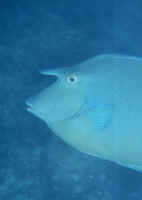
|
|
By Bob Fenner
|
Naso unicornis
|
Surgeonfishes: Tangs for Marine Aquariums
Diversity, Selection & Care
New eBook on Amazon: Available
here
New Print Book on Create Space: Available
here
by Robert (Bob) Fenner |
 |
Just how many unicorn or Naso tangs are there?
Most everyone knows the Naso, or lipstick surgeon, Naso
lituratus, but there are at least sixteen other species. All these
"Naso" tangs share the traits of being open, active swimmers,
surgeonfish "spines", and a propensity for getting BIG.
Unicornfishes are unlike other tang genera in their space
requirements, temperament and food needs. Here are my ideas of what
makes a good specimen, how to go about selecting them, and notes on
successful maintenance of Nasos in captivity.
Classification:
The family of surgeon, Doctorfishes or tangs,
Acanthuridae ("Ah-kan-thur-id-ee") is of immense use to the
saltwater aquarium hobby. Of the six genera and seventy two described
species, some are indeed "standards". How many can you name?
The three species of blue tangs, Bristlemouths of the genus
Ctenochaetus, the pelagic Prionurus, the mundane yellow
tang and other Zebrasoma, the many Acanthurus (powder
brown & blue, Achilles, gold rim, orange-shoulder, sohal, mimic,
clown...). The Acanthurids are an essential marine aquarium family.
The sub-family Nasinae, of one genus (Naso) and
about seventeen species are the Unicornfishes. They may be externally
distinguished from all other surgeonfishes by their possession of two
anal spines (versus three), and three soft pelvic rays (rather than
five). Like all surgeons, those of the genus Naso sport sharp
spiny processes (one or two) on their caudal peduncles; a formidable
weapon.
Genus Naso ("Nay-zoh") for the most part
is unknown to hobbyists with the exception of N. lituratus.
Though this celebrated species is the acknowledged "pick of the
litter" in color and markings, there are some other worthwhile
Nasos.
Unicornfishes come in slender, tubular shapes, as well as
more typical flattened "Acanthurus" form; with or
without "horns", all Naso species have similar care.
Here we'll expand only on the five that are principally available
in the hobby worldwide.
|
Naso brevirostris (Valenciennes 1835),
sometimes called the Shortnose Unicorn Tang, is mis-named both
scientifically and colloquially; it has a long nose as an adult.
There are Naso species with much shorter, even absent the
"horn" on the head. This grayish-green bodied fish is
occasionally imported from Hawaii and the Indo-Pacific. To two
feet long. Fr. Polynesia and Fiji pix.
http://fishbase.org/Summary/species
Summary.php?ID=6021&genusname=
Naso&speciesname=brevirostris
|
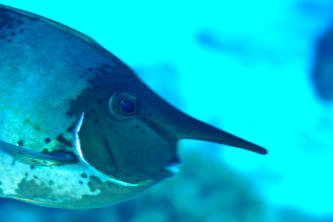
|
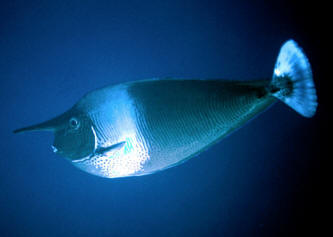 |
| Naso caesius Randall & Bell 1992, the
Gray Unicornfish. To about two feet in length. Pacific Ocean;
Marianas, Marshalls, Hawai'i, Noumea. Here off of Hawaii's
Big Island at a shallow water cleaning station, generally much
deeper. |
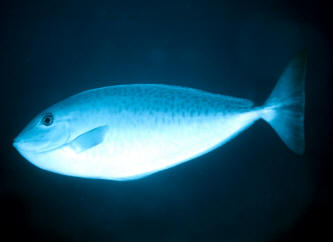
|
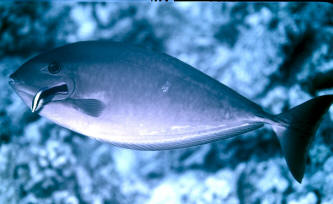 |
| Naso elegans the Indian Ocean (and Red Sea)
Orange-spined Unicornfish. To 45 cm.; similar to N. lituratus but found in
I.O. and RS. Also similar feeding (on macroalgae). Mauritius 2016. |
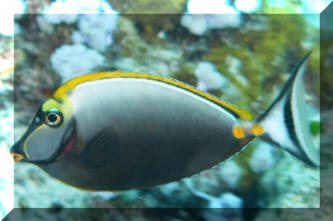
|
| Naso hexacanthus (Bleeker 1855), Sleek
Unicornfish. Indo-Pacific species... to about 30 inches in length.
Not kept in home aquariums... as are other too-large Naso species
from these islands. Neither males nor females develop a horn; but
do have black tongues! One in Hawaii, a flashing male in the Red
Sea shown below. This species has a dark margin
on its preopercle and operculum that helps distinguish it from
similar species. |
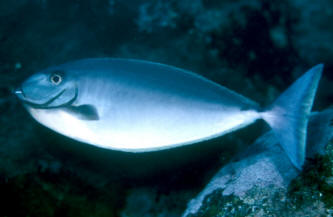 |
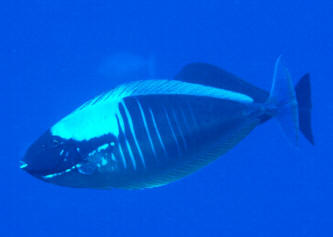 |
To:
Part 2, Part 3
Surgeonfishes: Tangs for Marine Aquariums
Diversity, Selection & Care
New eBook on Amazon: Available
here
New Print Book on Create Space: Available
here
by Robert (Bob) Fenner |
 |
|
|

